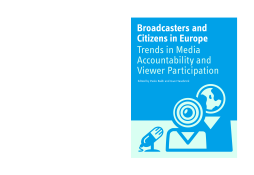
Additional Information
Book Details
Abstract
Broadcasting is arguably the most influential and powerful industry operating today. The media impose an inescapable presence in contemporary life and infuse all areas of public communication. But what is the quality of the relationship between ‘broadcaster’ and ‘citizen’? Do the media and media authorities take the audience's interests seriously into account? Do audiences have real opportunities to express themselves? Are citizens well informed and educated about the social, the cultural and the civic role that media can play? In this book, five authors present the main results of an extensive programme of research that was financed by the European Commission. The study was conducted in 29 European countries and each author analyses European trends from different but complementary perspectives.
Table of Contents
| Section Title | Page | Action | Price |
|---|---|---|---|
| Front Cover | FC | ||
| Preliminary Pages | 1 | ||
| Contents | 5 | ||
| Introduction: overview of a European study | 9 | ||
| Media accountability in Europe: a fragmented picture | 17 | ||
| 1. Media accountability is entering into the political agenda | 17 | ||
| 2. Europe: a highly fragmented picture | 18 | ||
| 2.1. Most-advanced countries | 18 | ||
| 2.2. Less-advanced countries | 24 | ||
| 2.3. The “under construction” countries | 28 | ||
| 3. Concluding remarks | 31 | ||
| UK broadcasting policy: the “long wave” shift in conceptions of accountability | 33 | ||
| Introduction | 33 | ||
| 1. Accountability: exit, voice and loyalty | 34 | ||
| 2. Accountability: proposals for change at the BBC | 37 | ||
| 3. UK broadcasting policy: the “long wave” shift in the dominant framework | 38 | ||
| 4. Conceptions of the citizen and the consumer in broadcasting policy | 39 | ||
| 4.1. Citizens’ “legitimate expectations” | 41 | ||
| 4.2. Social capital and new thoughts on citizenship | 42 | ||
| 4.3. Potter, consumer theory and evaluation of the accountability of UK broadcasters | 44 | ||
| 5. The 2003 Communications Act: a new consumer and citizen consciousness | 46 | ||
| 6.Conclusion | 49 | ||
| The protection of viewer rights in Europe | 53 | ||
| Introduction | 53 | ||
| 1. Basic general principles | 54 | ||
| 1.1. Media law | 54 | ||
| 1.2. Media authorities | 54 | ||
| 2. Main instruments and obligations | 55 | ||
| 2.1. Legal instruments for the viewers | 55 | ||
| 2.2. Legal obligations for the broadcasters | 57 | ||
| 3. Three types of countries | 58 | ||
| 3.1. Homogeneous countries | 58 | ||
| 3.2. Inhomogeneous countries | 64 | ||
| 3.3. Countries in progress | 69 | ||
| 4. Conclusion | 72 | ||
| Media users’ participation in Europe from a civil society perspective | 75 | ||
| Introduction | 75 | ||
| 1. Viewers – not just consumers | 75 | ||
| 2. Viewers – civil society actors? | 79 | ||
| 3. Options provided for viewer participation in Europe | 79 | ||
| 3.1. Representation in controlling bodies | 80 | ||
| 3.2. Communication platforms | 80 | ||
| 3.3. Complaints procedures | 81 | ||
| 3.4. Audience research | 82 | ||
| 4. Viewer associations | 82 | ||
| 4.1. Main objectives | 83 | ||
| 4.2. Types of activities | 86 | ||
| 5. Conclusions | 88 | ||
| 5.1. Viewer participation across Europe | 88 | ||
| 5.2. Viewer participation as civil society activity | 89 | ||
| 5.3. Viewer participation on the European level | 90 | ||
| Viewers’ rights in the European Union: policies and instruments | 93 | ||
| Introduction | 93 | ||
| 1. Access to the institutions: instruments and procedures | 94 | ||
| 1.1. European Parliament, Committee on Petitions | 94 | ||
| 1.2. European Commission: complaints concerning failure to comply with community law | 95 | ||
| 1.3. Actions brought to the Court of Justice of the European Communities (ECJ) | 96 | ||
| 1.4. The European Ombudsman | 97 | ||
| 1.5. European Court of Human Rights | 98 | ||
| 1.6. Internal Market law problem-solving network (Solvit) | 99 | ||
| 1.7. The European Consumer Centres and request for intervention to the European Extra-Judicial Network (EEJ-Net) | 99 | ||
| 2. General principles on consumer protection | 100 | ||
| 2.1. European Union | 101 | ||
| 2.2. Council of Europe | 101 | ||
| 3. Relevant EU policies and advisory bodies | 102 | ||
| 3.1. EU Consumer Affairs policy | 102 | ||
| 3.2. Audio-visual policy | 103 | ||
| 4. Conclusions | 104 | ||
| Abbreviations and Acronyms | 107 | ||
| References | 109 | ||
| About the authors | 115 | ||
| Back Cover | BC |
